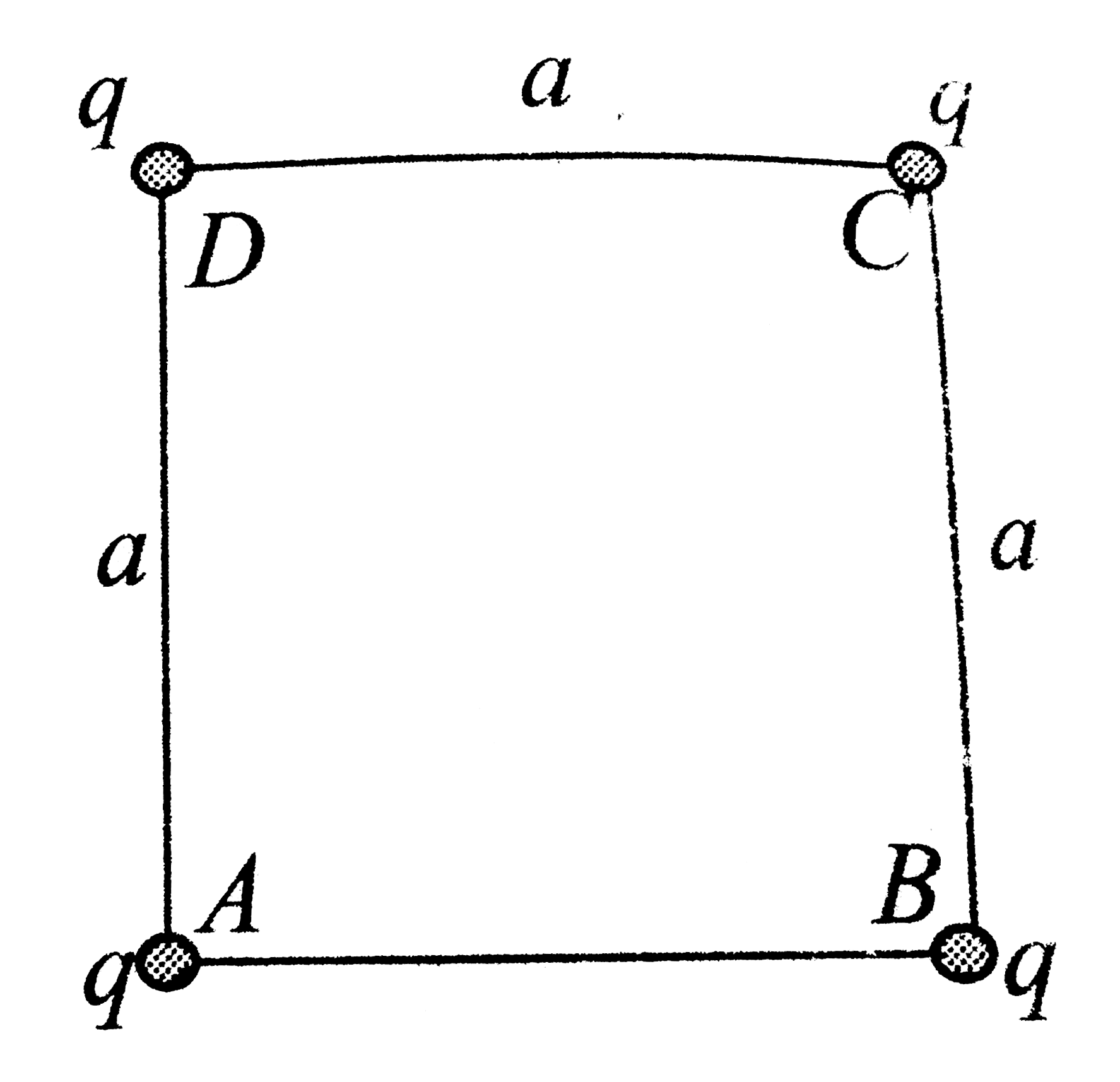Three equal charges, 2.0×10−6 C each, are held fixed at the three corners of a square of side 5 cm. find the Coulomb force experienced by one of the charges due to the rest two.
To find the Coulomb force experienced by one of the charges due to the other two charges, we can follow these steps:
Step 1: Identify the Charges and Their Positions
We have three equal charges, Q=2.0×10−6C, located at three corners of a square with a side length of a=5cm=0.05m. Let's denote the charges at the corners A, B, and C.
Step 2: Calculate the Force Between Charges
We will calculate the force on charge B due to charge A and charge C.
1. Force on B due to A:
The distance between charges A and B is a.
Using Coulomb's Law:
FAB=k⋅Q2a2
where k=9×109N m2/C2.
2. Force on B due to C:
The distance between charges B and C is also a.
Similarly,
FBC=k⋅Q2a2
Step 3: Calculate the Magnitude of Forces
Substituting the values into the equations:
FAB=FBC=9×109⋅(2.0×10−6)2(0.05)2
Calculating FAB and FBC:
FAB=FBC=9×109⋅4×10−120.0025=36×10−30.0025=14.4N
Step 4: Determine the Resultant Force
The forces FAB and FBC are perpendicular to each other (since they act along the sides of the square). Therefore, we can use the Pythagorean theorem to find the resultant force FR:
FR=√F2AB+F2BC=√(14.4)2+(14.4)2=√2⋅(14.4)2=14.4√2N
Calculating FR:
FR=14.4√2≈20.36N
Final Answer
The net Coulomb force experienced by charge B due to the other two charges is approximately 20.36N.
---
We have three equal charges, Q=2.0×10−6C, located at three corners of a square with a side length of a=5cm=0.05m. Let's denote the charges at the corners A, B, and C.
We will calculate the force on charge B due to charge A and charge C.
The distance between charges A and B is a.
Using Coulomb's Law:
FAB=k⋅Q2a2
where k=9×109N m2/C2.
The distance between charges B and C is also a.
Similarly,
FBC=k⋅Q2a2
Substituting the values into the equations:
FAB=FBC=9×109⋅(2.0×10−6)2(0.05)2
FAB=FBC=9×109⋅4×10−120.0025=36×10−30.0025=14.4N
The forces FAB and FBC are perpendicular to each other (since they act along the sides of the square). Therefore, we can use the Pythagorean theorem to find the resultant force FR:
FR=√F2AB+F2BC=√(14.4)2+(14.4)2=√2⋅(14.4)2=14.4√2N
FR=14.4√2≈20.36N
The net Coulomb force experienced by charge B due to the other two charges is approximately 20.36N.
Topper's Solved these Questions
- BOOK - HC VERMA ENGLISHCHAPTER - ELECTRIC FIELD AND POTENTIALEXERCISE - question for short answer14videos
ELECTRIC FIELD AND POTENTIAL
- BOOK - HC VERMA ENGLISHCHAPTER - ELECTRIC FIELD AND POTENTIALEXERCISE - Objective 19videos
ELECTRIC FIELD AND POTENTIAL
- BOOK - HC VERMA ENGLISHCHAPTER - ELECTRIC FIELD AND POTENTIALEXERCISE - worked out Examples19videos
ELECTRIC FIELD AND POTENTIAL
- BOOK - HC VERMA ENGLISHCHAPTER - ELECTRIC CURRENT THROUGH GASESEXERCISE - Short answer6videos
ELECTRIC CURRENT THROUGH GASES
- BOOK - HC VERMA ENGLISHCHAPTER - ELECTROMAGNETIC INDUCTIONEXERCISE - Questions for short answer9videos
ELECTROMAGNETIC INDUCTION
Similar Questions
Four equal charges 2.0×10−6C each are fixed at the four corners of a squae of side 5 cm. Find the coulomba force eperienced by one of the charges due to the rest three.
View SolutionCharges 5.0×10−7C,−2.5×10−7Cand1.0×10−7C are
held fixed at the three corners A, B, C of equilateral triangle of side 10cm respectively. Find the electric force on the charge at C due to the rest two.View SolutionFour identical charges q are placed at the corners of a square of side a. Find the potential energy of one of the charges due to the remaining charges.
 .View Solution
.View SolutionThree equal charge q0 each are placed at three corners of an equilateral triangle of side 'a'. Find out force acting on one of the charge due to other two charges ?
View SolutionThree charges, each equal to q, are placed at the three. corners of a square of side a . Find the electric field at. the fourth corner.
View SolutionThree charges, each equal to q, are placed at the three. corners of a square of side a . Find the electric field at. the fourth corner.
View SolutionThree equal charges, each having a magnitude of. 2.0×10−6C, are placed at the thre corners of a right. angled triangle of sides 3 cm, 4cm and 5 cm. find the force (in magnitude) on the charge at the right angled
View SolutionCharges of +103×10−9C are placed at each of the four corners of a square of side 8cm. The potential at the intersection of the diagonals is
View SolutionThree identical charges, each having a value 1.0×10−8C, are placed at the corners of an equilateral triangle of side 20 cm find the electric field and potential at the centre of the triangle.
View SolutionTwo equal charges, 2.0×10−7C each, are held fixed at a separation of 20cm. A third charge of equal magnitude is placed midway between the two both the charges. How much work is done by the electric field during the process?
View Solution
